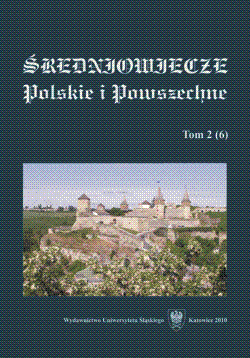Zjazd w Łęczycy w 1430 roku. Z badań nad wydarzeniami politycznymi w Polsce podczas "burzy koronacyjnej" 1429-1430.
A Convention in Łęczyca in 1430. From the studies on political events in Poland during the “coronation storm” 1429—1430
Author(s): Sobiesław SzybkowskiSubject(s): History
Published by: Wydawnictwo Uniwersytetu Śląskiego
Summary/Abstract: Jan Długosz, in his "Annals", during the first eight months of 1430, the period incredibly important for Poland because of the so called coronation storm at that time, that is the attempt of Witold Kiejstutowicz, a great duke of Lithuania to get the crown, presented the tour of king Władysław Jagiełło over Szeroka Wielkopolska, from April to August, in a very hackneyed way. In the meantime, the data quoted prove that during the monarch’s stay in Łęczyca, there was a convention of the king with the rich and gentry of Szeroka Wielkopolska. Most probably, the events related to the coronation storm happening after the convention in Jedlna (February/March 1430) were summed up. Political consultations in Łęczyca were conducted by the king exclusively in the circle consisting of the archbishop from Gniezno, other bishops from Wielkopolska, a bishop from Chełm, a chancellor (also being a bishop in Włocławek), a vice‑chancellor and high- and low-ranking officials from the territory of Wielkopolska sensu stricte, Kujawy, Łęczyca, Sieradz, Dobrzyń lands, representatives from Mazowsze and few Małopolska confidantes (Jan from Szczekociny, Piotr Szafraniec). Perhaps it resulted in the the lack of the information about the convention in Łęczyca in Jan Długosz, fairly thoroughly describing the political events of 1430 in his chronicle. Thus, a chronicle could have no information about this fact, especially when the sources do not indicate that his political mentor was there: Jan Oleśnicki, a bishop from Kraków. During the tour over Szeroka Wielkopolska, king Władysław also made relatively many new nominations to high land officials of middle Polish hierarchy as a result of death of the previous land possessors. The very nominations introduced relatively young people in majority. As a result, the majority of the nominated remained in the composition of the political elite all over Poland till the beginning of the ruling of Kazimierz Jagiellończyk, Jagiełło’s younger son. They also played an important role during tutelary ruling at the time of minority of Władysław III (1434—1438), his absence in the country (1440—1444) and interregnum after his death. It is not out of the question that the parts of the nominations in question were made just at the convention in Łęczyca, at last after its end.
Journal: Średniowiecze Polskie i Powszechne
- Issue Year: 2010
- Issue No: 6
- Page Range: 142-156
- Page Count: 15
- Language: Polish

